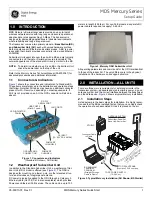
Chapter IV : S9 III Operations
33
IV.4 Operation of lights
Static mode
The STATIC and power light will keep lighted. When satellites fulfill the conditions (at least 4
GPS or 4 GLONASS satellite, PDOP< 3.5), receiver will start recording epochs, you will hear a
beep, STATIC light will flash according to sampling interval (if you don’t set up, the default is 1
second) and the satellite light will flash a number of times equal to the locked satellites.
Base mode
After setting up the mode, power on the mainframe, the base will enter into the transmit mode,
Using external radio EXTERNAL light flashing every one second means the base transmit
normal, the interval is 1 second. In the same way using built-in radio INTERNAL RADIO light
will flash. If you need to change
the transmit conditions, you should connect the handheld with
mainframe by cable or Bluetooth firstly.
Rover mode
Bluetooth and power light will keep lighted. The satellite light will blink according to the
number of satellites as described for static mode.
Using GPRS/GSM, GSM/GPRS light starts to blink with the frequency of the received data
packets . In the same way using built-in radio INTERNAL RADIO light will flash.
IV.5 How to measure the antenna height
The height of receiver is 99mm, the diameter is 190mm, the height from the center of the
sealed rubber ring to the bottom is 62mm.
The antenna height is conventionally defined as the vertical height from the phase centre to the
ground surveyed point (the distance “h” in fig. 4.3). It is not possible to measure it directly: you
have to measure other reachable heights (the distances “a”, “d”, “s” in fig.4.3). The distance “a” is
the vertical height from the ground to the mainframe’s bottom, “d” is the vertical height from
the ground to the middle of the rubber ring: both are defined as “vertical heights”. On the
















































